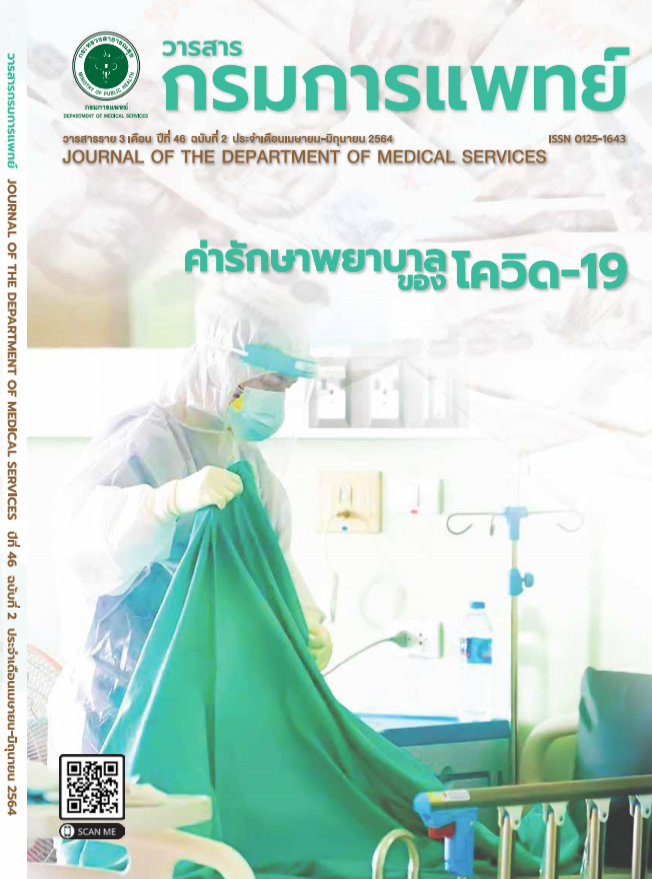การเปรียบเทียบความทนแรงอัดระหว่างกลาสไอโอโนเมอร์ ซีเมนต์ที่เสริมแรงด้วยเซอร์โคเนีย และอะมัลกัม
คำสำคัญ:
ความทนแรงอัด, กลาสไอโอโนเมอร์ซีเมนต์ที่เสริมแรงด้วยเซอร์โคเนีย, อะมัลกัม, กลาสไอโอโนเมอร์ซีเมนต์ชนิดดั้งเดิมบทคัดย่อ
ภูมิหลัง: ปัจจุบันแนวโน้มการอุดฟันโดยใช้อะมัลกัมลดลง เนื่องจากมีการพัฒนาของระบบสารยึดติด และความเป็นพิษจาก สารปรอท นอกจากนี้ยังมีการพัฒนาวัสดุอุดในกลุ่มสีคล้ายฟัน ซึ่ง ในกลาสไอโอโนเมอร์ซีเมนต์มีคุณสมบัติที่เป็นวัสดุอุดที่ดี คือมีการ ปลดปล่อยฟลูออไรด์ป้องกันฟันผุได้ แต่มีข้อด้อย คือ ค่าความ ทนแรงอัดต่ำ จึงมีการพัฒนาโดยการเติมสารเซอร์โคเนียเป็นวัสดุ สีคล้ายฟันและมีค่าความทนแรงอัดสูงวัตถุประสงค์: เพื่อเปรียบ เทียบความทนแรงอัดระหว่างกลาสไอโอโนเมอร์ซีเมนต์ที่เสริมแรง ด้วยเซอร์โคเนีย อะมัลกัม และ กลาสไอโอโนเมอร์ซีเมนต์ชนิด ดั้งเดิมวิธีการ: ทำชิ้นทดสอบขนาดเส้นผ่านศูนย์กลาง 4 มิลลิเมตร หนา 6 มิลลิเมตร ทั้งหมด 30 ชิ้น วัสดุละ 10 ชิ้น แต่ละวัสดุจะมี 2 กลุ่มทดสอบ คือ กลุ่มเวลา 1 ชั่วโมง และ 24 ชั่วโมง รวมกลุ่ม ทดสอบทั้งหมด 6 กลุ่ม จากนั้น นำมาวัดความทนแรงอัดด้วยเครื่อง ทดสอบเอนกประสงค์ชนิด Statics (Universal Testing Machine: Static, Instron 5566) โดยใช้ความเร็วหัวทดสอบที่ 0.5 มิลลิเมตร ต่อนาที ทดสอบจนเกิดการแตกหักของวัสดุแล้วบันทึกผล จากนั้น นำข้อมูลมาเปรียบเทียบค่าเฉลี่ยความทนแรงอัดในแต่ละกลุ่มโดย ใช้สถิติ one-way ANOVAผล: เมื่อเปรียบเทียบ ค่าความทนแรง อัดเฉลี่ยของอะมัลกัม กลาสไอโอโนเมอร์ซีเมนต์ที่เสริมแรงด้วย เซอร์โคเนีย และ กลาสไอโอโนเมอร์ซีเมนต์ชนิดดั้งเดิม ทั้ง 2 ช่วง เวลา คือ ที่ 1 และ 24 ชั่วโมง โดยที่ 1 ชั่วโมง พบว่า ความทนแรง อัดเฉลี่ยไม่แตกต่างกัน ระหว่าง กลาสไอโอโนเมอร์ซีเมนต์ที่เสริมแรง ด้วยเซอร์โคเนียกับอะมัลกัม และมีค่ามากกว่ากลาสไอโอโนเมอร์ ซีเมนต์ชนิดดั้งเดิม อย่างมีนัยสำคัญทางสถิติที่ระดับ 0.05 ส่วนที่ 24 ชั่วโมง พบว่าค่าความทนแรงอัดเฉลี่ยแตกต่างกันอย่างมีนัยสำคัญ ทางสถิติที่ระดับ 0.05 ทั้ง 3 กลุ่ม โดยที่ อะมัลกัมมีค่ามากที่สุด และ กลาสไอโอโนเมอร์ซีเมนต์ที่เสริมแรงด้วยเซอร์โคเนีย กลาสไอโอโนเมอร์ ซีเมนต์ชนิดดั้งเดิมลดลงมาตามลำดับสรุป: การเติมสารเซอร์โคเนีย เพิ่มความแข็งแรงของกลาสไอโอโนเมอร์ซีเมนต์ เมื่อเปรียบเทียบ กับกลาสไอโอโนเมอร์ซีเมนต์ชนิดดั้งเดิมและแข็งแรงเทียบเท่ากับ อะมัลกัมที่ 1 ชั่วโมง แต่แข็งแรงน้อยกว่าอะมัลกัมที่ 24 ชั่วโมง
เอกสารอ้างอิง
The 8th National Oral Health Survey, Thailand, 2017. Bureau of Dental Public Health, Department of Health,Ministry of Public Health; 2018.
Anusavice KJ. 1 – Overview of preventive and restorative materials. In: Anusavice KJ, Shen C, Rawls HR, editors.Phillips’Science of Dental Materials. 12th ed. St. Louis, Mo: Elsevier Health Sciences; 2013. p. 3-16.
Murdoch-Kinch CA, McLean ME. Minimally invasive dentistry. J Am Dental Assoc2003;134:87-95.
Khalaf ME, Alomari QD, Omar R. Factors relating to usage patterns of amalgam and resin composite for posterior restorations – a prospective analysis. J Dent 2014;42:785-92.
Dunne SM, Grainsford ID, Wilson NH. Current materials and techniques for direct restorations in posterior teeth. Part 1: Silver amalgam. Int Dent J. 1997;47:123–36.
Nicholson J, Czarnecka B. 2 - Classification of restorative materials and clinical indications. In: Nicholson J,Czarnecka B,editors. Materials for the Direct Restoration of Teeth: Woodhead Publishing; 2016. p. 21-36.
Berg JH. Glass ionomer cements. Pediatric dentistry 2002;24:430-8.
Moshaverinia A, Ansari S, Movasaghi Z, Billington RW, Darr JA,Rehman IU. Modification of conventional glass-ionomer cements with N-vinylpyrrolidone containing polyacids, nano-hydroxy and fluoroapatite to improve mechanical properties. Dent Mater 2008;24:1381–90.
Upadhya PN, Kishore G. Glass ionomer cement - The different generations. Trends in Biomaterials and Artificial Organs 2005;18:158-65.
Walls AWG. Glass polyalkenoate (glass-ionomer) cements: a review. J Dent 1986;14:231-46.
Denry I, Kelly JR. State of the art of zirconia for dental applications. Dent Mater 2008;24:299-307.
Abdulsamee N, Elkhadem AH. Zirconomer and Zirconomer Improved (White Amalgams): Restorative Materials for the Future.[Review]. EC Dental Science 2017;15:134–50.
International organization for standardization. ISO 9917-1:2003 Dentistry -- Water based cements -- Part 1:Powder/liquid acid-base cements; 2003.
Pereira LC, Nunes MC, Dibb RG, Powers JM, Roulet JF, Navarro MF. Mechanical properties and bond strength of glass-ionomer cements. J Adhes Dent 2002;4:73-80.
Bresciani E, Barata Tde J, Fagundes TC, Adachi A, Terrin MM,Navarro MF. Compressive and diametral tensile strength of glass ionomer cements. J Appl Oral Sci 2004;12:344-8.
Dheeraj M, Johar S, Jandial T, Sahi H, Verma S. Comparative Evaluation of Compressive Strength and Diametral Tensile Strength of Zirconomer with GIC and Amalgam. J Adv Med Dent Scie Res 2019;7:52-6.
Chalissery VP, Marwah N, Almuhaiza M, AlZailai AM, Chalisserry EP, Bhandi SH, et al. Study of the Mechanical Properties of the Novel Zirconia-reinforced Glass lonomer Cement. J Contemp Dent Pract 2016;17:394-8.
International organization for standardization. ISO 24234: 2004.Dentistry - Mercury and alloys for dental amalgam; 2004.
Iguodala-Cole BO, Aboush YEY, Vowles RW, Elderton RJ.Challenging the ISO and BSI specifications for glass-ionomer cements: Effect of specimen size upon compressive and tensile strength measurements. Clinical Materials 1991;7:333-4.
Mallmann A, Ataide JC, Amoedo R, Rocha PV, Jacques LB.Compressive strength of glass ionomer cements using different specimen dimensions. Braz Oral Res 2007;21:204-8.
Nomoto R, McCabe JF. Effect of mixing methods on the compressive strength of glass ionomer cements. J Dent 2001;29:205-10.
Bhatia HP, Singh S, Sood S, Sharma N. A Comparative Evaluation of Sorption, Solubility, and Compressive Strength of Three Different Glass Ionomer Cements in Artificial Saliva: An in vitro Study. Int J Clin Pediatr Dent 2017;10:49-54.
Shetty C, Sadananda V, Hegde M, Lagisetti A, Shetty A, Mathew T, et al. Comparative Evaluation of Compressive Strength of Ketac Molar, Zirconomer, and Zirconomer Improved. Scholars Journal of Dental Sciences 2017;4:259-61.
Bonifacio CC, Kleverlaan CJ, Raggio DP, Werner A, de Carvalho RC, van Amerongen WE. Physical-mechanical properties of glass ionomer cements indicated for atraumatic restorative treatment.Aust Dent J 2009;54:233-7.
ดาวน์โหลด
เผยแพร่แล้ว
รูปแบบการอ้างอิง
ฉบับ
ประเภทบทความ
สัญญาอนุญาต

อนุญาตภายใต้เงื่อนไข Creative Commons Attribution-NonCommercial-NoDerivatives 4.0 International License.
บทความที่ได้รับการตีพิมพ์เป็นลิขสิทธิ์ของกรมการแพทย์ กระทรวงสาธารณสุข
ข้อความและข้อคิดเห็นต่างๆ เป็นของผู้เขียนบทความ ไม่ใช่ความเห็นของกองบรรณาธิการหรือของวารสารกรมการแพทย์



